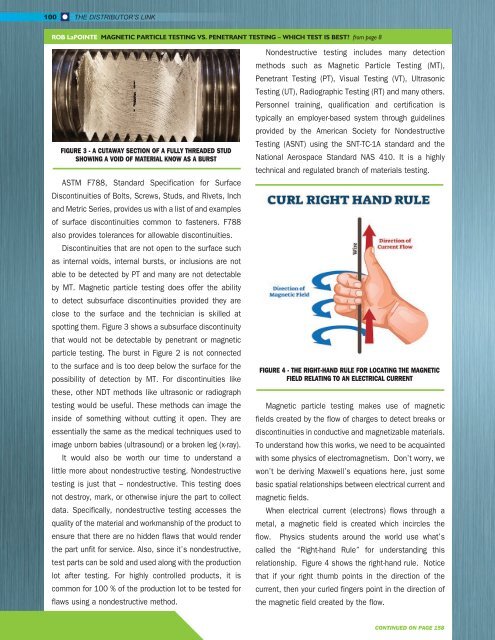FALL 2021
Distributor's Link Magazine Fall 2021 / Vol 44 No 4
Distributor's Link Magazine Fall 2021 / Vol 44 No 4
You also want an ePaper? Increase the reach of your titles
YUMPU automatically turns print PDFs into web optimized ePapers that Google loves.
100<br />
THE DISTRIBUTOR’S LINK<br />
ROB LaPOINTE MAGNETIC PARTICLE TESTING VS. PENETRANT TESTING – WHICH TEST IS BEST? from page 8<br />
FIGURE 3 - A CUTAWAY SECTION OF A FULLY THREADED STUD<br />
SHOWING A VOID OF MATERIAL KNOW AS A BURST<br />
ASTM F788, Standard Specification for Surface<br />
Discontinuities of Bolts, Screws, Studs, and Rivets, Inch<br />
and Metric Series, provides us with a list of and examples<br />
of surface discontinuities common to fasteners. F788<br />
also provides tolerances for allowable discontinuities.<br />
Discontinuities that are not open to the surface such<br />
as internal voids, internal bursts, or inclusions are not<br />
able to be detected by PT and many are not detectable<br />
by MT. Magnetic particle testing does offer the ability<br />
to detect subsurface discontinuities provided they are<br />
close to the surface and the technician is skilled at<br />
spotting them. Figure 3 shows a subsurface discontinuity<br />
that would not be detectable by penetrant or magnetic<br />
particle testing. The burst in Figure 2 is not connected<br />
to the surface and is too deep below the surface for the<br />
possibility of detection by MT. For discontinuities like<br />
these, other NDT methods like ultrasonic or radiograph<br />
testing would be useful. These methods can image the<br />
inside of something without cutting it open. They are<br />
essentially the same as the medical techniques used to<br />
image unborn babies (ultrasound) or a broken leg (x-ray).<br />
It would also be worth our time to understand a<br />
little more about nondestructive testing. Nondestructive<br />
testing is just that – nondestructive. This testing does<br />
not destroy, mark, or otherwise injure the part to collect<br />
data. Specifically, nondestructive testing accesses the<br />
quality of the material and workmanship of the product to<br />
ensure that there are no hidden flaws that would render<br />
the part unfit for service. Also, since it’s nondestructive,<br />
test parts can be sold and used along with the production<br />
lot after testing. For highly controlled products, it is<br />
common for 100 % of the production lot to be tested for<br />
flaws using a nondestructive method.<br />
Nondestructive testing includes many detection<br />
methods such as Magnetic Particle Testing (MT),<br />
Penetrant Testing (PT), Visual Testing (VT), Ultrasonic<br />
Testing (UT), Radiographic Testing (RT) and many others.<br />
Personnel training, qualification and certification is<br />
typically an employer-based system through guidelines<br />
provided by the American Society for Nondestructive<br />
Testing (ASNT) using the SNT-TC-1A standard and the<br />
National Aerospace Standard NAS 410. It is a highly<br />
technical and regulated branch of materials testing.<br />
FIGURE 4 - THE RIGHT-HAND RULE FOR LOCATING THE MAGNETIC<br />
FIELD RELATING TO AN ELECTRICAL CURRENT<br />
Magnetic particle testing makes use of magnetic<br />
fields created by the flow of charges to detect breaks or<br />
discontinuities in conductive and magnetizable materials.<br />
To understand how this works, we need to be acquainted<br />
with some physics of electromagnetism. Don’t worry, we<br />
won’t be deriving Maxwell’s equations here, just some<br />
basic spatial relationships between electrical current and<br />
magnetic fields.<br />
When electrical current (electrons) flows through a<br />
metal, a magnetic field is created which incircles the<br />
flow. Physics students around the world use what’s<br />
called the “Right-hand Rule” for understanding this<br />
relationship. Figure 4 shows the right-hand rule. Notice<br />
that if your right thumb points in the direction of the<br />
current, then your curled fingers point in the direction of<br />
the magnetic field created by the flow.<br />
CONTINUED ON PAGE 158
















